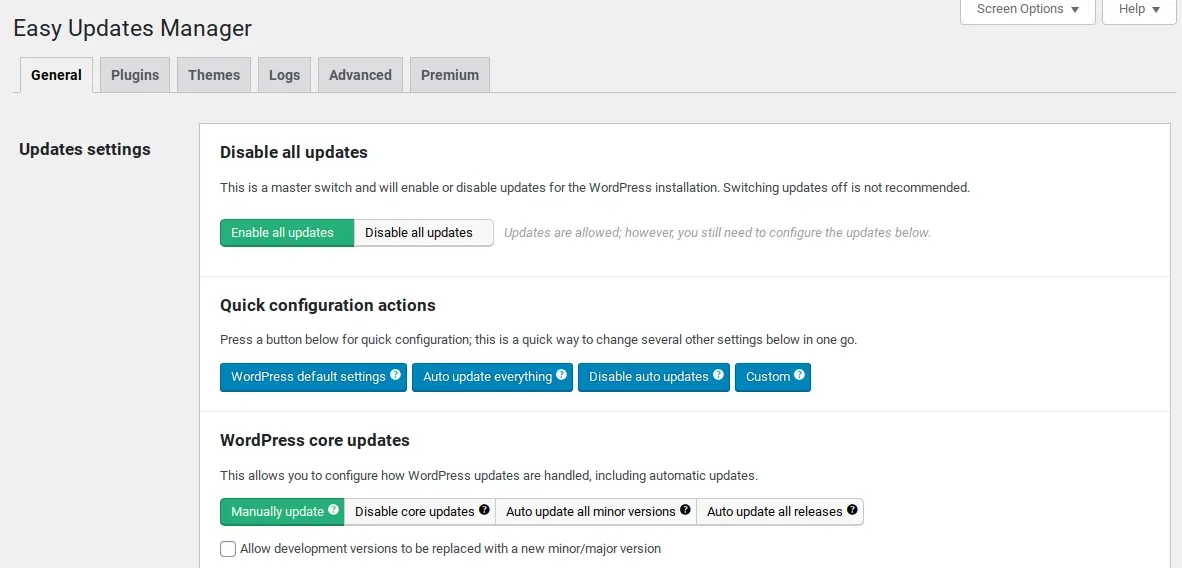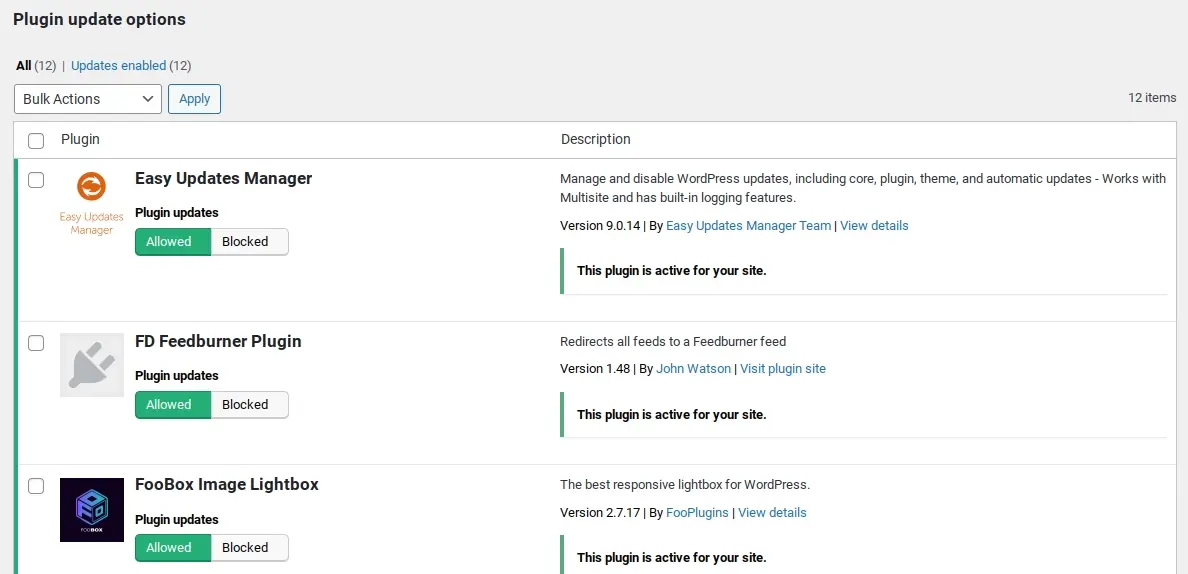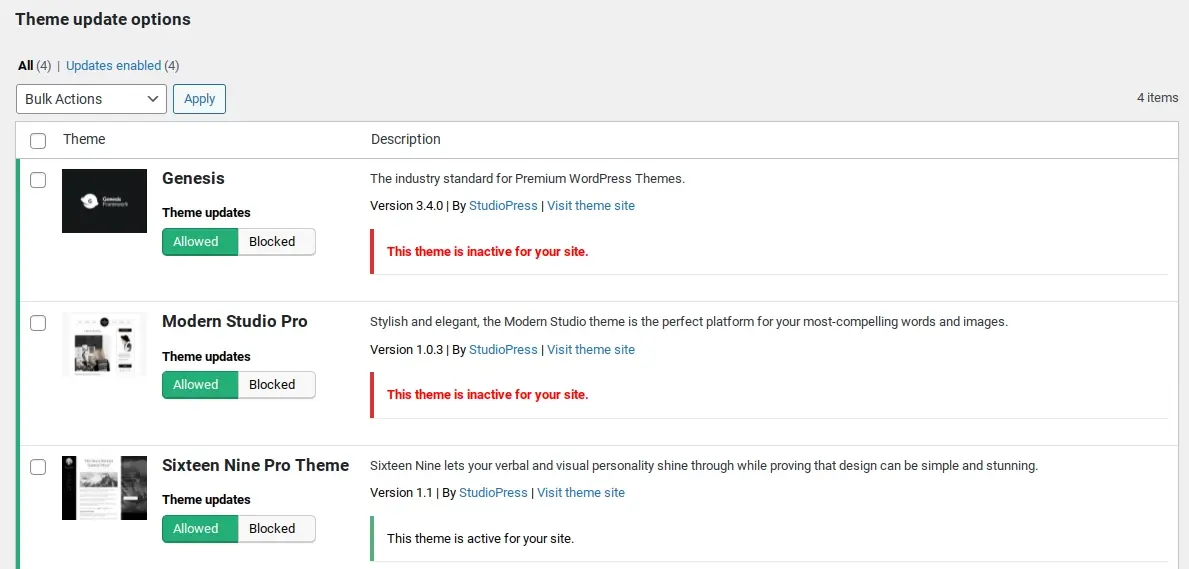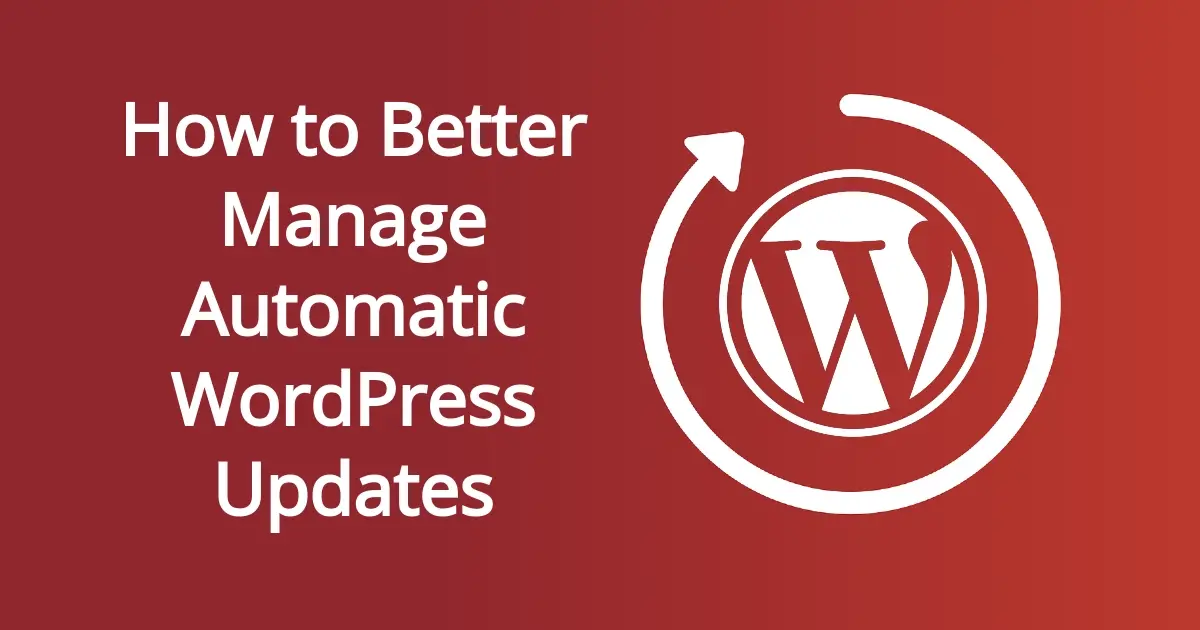Automatic WordPress updates have been around since version 3.7. This feature was designed to help encourage WordPress website owners to update their website regularly. However, you might not want to rely solely on automatic WordPress updates and implement a better way. In this article, you’ll learn how to better manage automatic WordPress updates.
What is updated automatically by WordPress?
Automatic WordPress updates usually include:
- WordPress core updates
- WordPress plugin updates
- WordPress theme updates
- WordPress translation file updates
**WordPress core updates
WordPress core updates involve the entire wp-admin and wp-include folders, as well as any root WordPress files. Any update applied is usually involving new features, security patches, and improving existing code.
WordPress core updates are divided into major releases and minor releases. Minor releases usually involved security patches and tweaking some areas of what was released in the previous major update. A major update may contain some security patches, but they usually include a lot of new features or updating of existing features.
**WordPress plugin updates
WordPress plugin updates involve any plugin that you have installed, whether activated or not.
**WordPress theme updates
WordPress theme updates include any installed theme, no matter if they are currently active.
**WordPress translation file updates
WordPress translation file updates include any file for WordPress core, themes, or plugins that were translated into any dialect. Sometimes these files require more translation depending if there are new areas within WordPress, a plugin, or a theme that the user will need to read.
Should you rely on automatic WordPress updates?
Updating your website is super important, and even a responsibility that your web host requires of you. Updates allow for your site to not only run smoothly, but securely. Code for PHP and other markup languages are always changing and evolving, which also means that there’s also a lot of hackers putting together code to infiltrate any vulnerabilities within your site.
However, it’s important to find a balance between automatic WordPress updates and not entirely jump on the bandwagon. In just allowing automatic WordPress updates to keep running, without being entirely aware of how the process is done, you may end up eventually running into a problem where your site either doesn’t update right or an error shows up.
The best way to handle updating WordPress is to make sure you backup your site first, and then update. However, if you trust some updates over others, you can use a method with a plugin or without a plugin to better manage automatic WordPress Updates.
How to Manage Automatic WordPress Updates with a plugin

If you’re not comfortable handling a few code snippets and adding them to a file, you can use a plugin to manage automatic WordPress updates. For this article, you’ll be using the Easy Updates Manager plugin.
Once you install and activate the Easy Updates Manager plugin, you can find the Update Options under the Dashboard section of your WordPress admin menu.
The areas you will want to take a look at and adjust are:
- General Settings
- Plugins
- Themes
General Settings

The General settings of the Easy Updates Manager plugin allow you to either enable or disable all automatic WordPress updates, or just disable some automatic updates. You can also opt to have the plugin email you when an update has been done.
When going through the general settings of this plugin, you may want to only allow automatic updates of minor releases, and then manage automatic updates of specific themes or plugins individually.
Plugins

The plugin settings for Easy Updates manager lists all active and inactive plugins that are installed on your WordPress website. You can toggle to either allow or block automatic WordPress updates.
If you have some inactive plugins installed, it’s best to remove them, even if you only use them for specific tasks. A plugin that is inactive has the potential to be a security risk down the line, especially if it becomes an abandoned plugin (one that the developer has stopped developing and providing updates for.)
Themes

The theme settings section of the Easy Updates manager plugin lists all active and inactive themes that you’ve installed. You can toggle to allow or block any automatic WordPress updates.
As a note, if you have a ton of themes installed, you should only keep your active theme or child theme, parent theme (if you have a child theme), and a default WordPress theme like Twenty Twenty-Three.
How to Better Manage Automatic WordPress Updates without a plugin
If you prefer not to use any plugins, and you’re comfortable with handling code, then this option might be for you. Any of these options simply require you to add the snippet of code to your wp-config.php file.
- Disable ALL WordPress Updates
- Disable Automatic WordPress Core Updates
Disable ALL WordPress Updates
To disable all automatic WordPress updates, you can add the following code to your wp-config.php file:
define( 'AUTOMATIC_UPDATER_DISABLED', true );
Disable Automatic WordPress Core Updates
If you only want to disable WordPress core from automatically updating, then add the following code to your wp-config.php file:
define( 'WP_AUTO_UPDATE_CORE', true );
If you decide at one point to turn it back on, but don’t want to remove the code, then change the ‘true’ to ‘false’. Additionally, if you only wish to allow minor automatic WordPress core updates, then you can change the ‘true’ to ‘minor’.
In the case you need to make sure specific themes or plugins are updating, you can apply a filter. You can learn more about controlling those background updates here. Just make sure that before you add any of these code snippets, that you create a backup of your site.
In Summary
If you’re allowing any automatic updates, make sure to have scheduled backups in case an update goes wrong. Ideally, the best way to handle updates, if you have a backup plan in place, is to not allow major automatic updates. There’s no real harm if you are allowing automatic updates, but it’s important to be a bit cautious, and test any major release.
Hopefully one of the solutions in this article on how to better manage automatic WordPress updates will help you.
At Verpex, we provide a variety of dedicated hosting solutions for WordPress that can assist you in launching a site for your company or brand that is safe, quick, and successful.
Verpex is an excellent option for web hosting if you want to be sure that the website you designed using Wordpress is built on a stable base. All of our hosting plans for WordPress are built for speed and performance, so your site will run smoothly.
Frequently Asked Questions
Is WordPress free?
All you need to do to use WordPress is to invest in a web hosting plan since the software itself is free.
Why choose Verpex for WordPress?
As the leading CMS out there, we’ve made it our mission to offer the most comprehensive and streamlined WordPress solutions on the market. Backed by a responsive customer care team and reliable site enhancement tools, we ensure our users get the full WordPress value and support for a reasonable price.
How do I get help with my WordPress site?
There’s never a moment we won’t be here to support the development of your website and your business. Unlike many of our competitors, we’re online 24/7, providing support to our users whenever they need it. We provide a live chat experience so we can quickly communicate in real time, meaning you can swiftly get back to enhancing your customers’ experiences.
Which WordPress features will I need the most?
The amount of sites you can host on your reseller server is basically limitless. The only thing holding you back is the amount of cPanel accounts you can host, and this depends entirely on the hosting provider that you choose. With Verpex, you have the choice of three plans: Start-Up, Pro, and Ultimate.
As the names suggest, each plan is designed to meet the scaling requirements of reseller hosters, with options for new starters through to experienced users with large demands. Respectively, the plans have 15, 50, and 100 cPanel accounts included.

Nile Flores is a long time professional blogger, as well as WordPress website designer and developer from the St. Louis Metro East. Nile blogs at NileFlores.com, where she’s passionate about helping website owners, whether they’re small business owners or bloggers. She teaches about Blogging, Social Media, Search Engine Optimization, Website Design, and WordPress. Additionally, Nile loves to speak at WordCamps (WordPress conferences) across the United States. When Nile isn’t knee-deep in coding, she’s a proud mom of a college student, and enjoys oil painting, cigar smoking, nail art design, and practicing traditional Okinawan kempo karate.
View all posts by Nile Flores



















